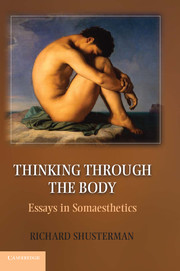Book contents
- Frontmatter
- Contents
- Preface
- Introduction
- Part I Somatic Being, Knowing, and Teaching
- Part II Somaesthetics, Aesthetics, and Culture
- Part III The Arts and the Art of Living
- 10 Somaesthetics and Architecture
- 11 Photography as Performative Process
- 12 Asian Ars Erotica and the Question of Sexual Aesthetics
- 13 Somaesthetic Awakening and the Art of Living
- 14 Somatic Style
- Select Bibliography
- Index
- References
11 - Photography as Performative Process
Published online by Cambridge University Press: 05 November 2012
- Frontmatter
- Contents
- Preface
- Introduction
- Part I Somatic Being, Knowing, and Teaching
- Part II Somaesthetics, Aesthetics, and Culture
- Part III The Arts and the Art of Living
- 10 Somaesthetics and Architecture
- 11 Photography as Performative Process
- 12 Asian Ars Erotica and the Question of Sexual Aesthetics
- 13 Somaesthetic Awakening and the Art of Living
- 14 Somatic Style
- Select Bibliography
- Index
- References
Summary
I
Photography pervades our lives. Its multiple and wide-ranging roles make it not only ubiquitous but also immensely diverse. There are photo IDs; all sorts and styles of advertising images; documentary shots of news and sports events; criminal “wanted” posters; scientific photographs to serve either as heuristics in the process of discovery or as evidentiary tools for proof and teaching; portrait shots of individuals, families, or other groups (including school or conference pictures); candidly intimate photos reserved for someone special; personal travel photos (now typically in digital form and shared with friends through some internet network); and then there is art photography, which is what concerns me here and which constitutes a diversely mixed genre in itself.
A distinctively modern art (one not to be found in Hegel's famous nineteenth-century classificatory rankings), photography's association with newness is not merely temporal but indeed reflects a tendency toward continuing innovation. Its original photochemical film technique engendered new forms such as movies and videos, but it also led to the new varieties of digital photography that dispense with the photochemistry of film and instead use sensors that convert light into electrical charges that are then digitally analyzed and converted back into images. Photography's artistic uses display continuing innovation, such as the distinctive trend that began in the late 1970s of creating very large-scale photographs expressly meant for posting on the gallery wall and typically “summoning a confrontational experience on the part of the spectator that sharply contrasts with the habitual processes of appropriation and projection whereby photographic images are normally received and consumed.”
- Type
- Chapter
- Information
- Thinking through the BodyEssays in Somaesthetics, pp. 239 - 261Publisher: Cambridge University PressPrint publication year: 2012



